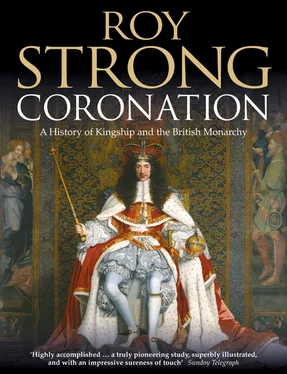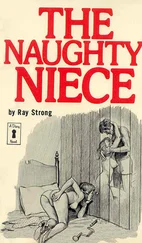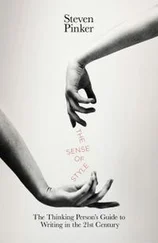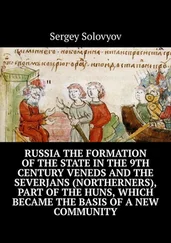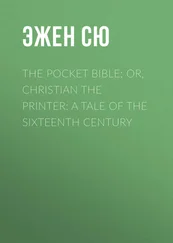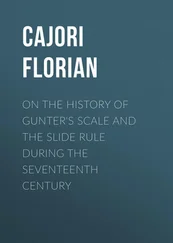The Second Recension recast the nature, context and function of kingship. Much of that is caught in the new items of regalia. The ring, which makes its first appearance in the ordination of bishops, is given as a symbol of faith. The sword, for which there is also no pagan precedent, is girded upon the king for the defence of both the Church and his own people. 23 The recension also integrates the Queen into the Coronation ritual, casting her in the role of a virtuous helpmate. She, too, was anointed with chrism, an index of high status and that her role was seen as important and not subsidiary to that of the king. 24
Apart from the unusually full account of the Second Recension in action for Edgar in 973 little if anything is known about the Coronations of later kings. Indeed, it is not known whether Canute, the Danish king who succeeded to England by conquest, was even crowned at all. Chaos followed his demise in 1035 until, seven years later in 1042, Canute’s stepson, Edward the Confessor, succeeded. By that date the place of crowning was still not fixed, for Edward’s took place at Winchester in 1043. The Anglo-Saxon Chronicle provides us with a crumb about that event, one which shows that the importance of the promissio regis was fully understood, for we are told that Eadsige, Archbishop of Canterbury, ‘gave him [Edward] good instruction before all the people, and admonished him well for his own sake and for the sake of all the people’. 25 If the Second Recension was a perfect mirror of ideal Anglo-Saxon kingship, what replaced it after the Norman Conquest was to reflect a far more assertive and controversial vision of the monarchy in what was to be an age of conflict between Church and State. There is a striking representation of the last Saxon Coronation in the Bayeux Tapestry. On 6 January 1066 Harold was crowned King in Edward the Confessor’s new Abbey Church of Westminster, which had been consecrated only nine days before. His claim to the throne was tenuous, his mother being a Norse princess and his sister, the Confessor’s Queen. The Coronation took place the day after the Confessor’s death, so that any preparations must have been minimal. The tapestry is accepted as having been made in England in about 1075 and its English origins mean that the scene is as it would have been envisaged by those within the native tradition. But the storyline is that of the Norman conquerors, for what is depicted is what, in their eyes, was a usurpation and, although no doubt both the archbishops of Canterbury and York took part following the Second Recension ordo, York is omitted in favour of including the tainted Stigand of Canterbury, already under a cloud and deposed from the see in 1070.
Such an image is, of course, not reportage but symbolic. Nonetheless it evokes more vividly than the dead texts of the ordines something of the atmosphere of such an event as well as giving an indication of the visual spectacle. It suggests that the royal throne had advanced from the primitive bench on which Edward the Confessor sits in the tapestry to being something more akin to an elevated seat or chair with an approach by way of steps. Harold wears the familiar late Anglo-Saxon crown with fleurons on his head and also sports a royal mantle, suggesting, perhaps, as some versions of the ordines say, that this may have been part of the regalia by 1066. To his right there are two principes, one of whom lifts high what may be the sword with which the king was girded during the ceremony. In his right hand he supports a long foliated rod, a baculus, and, in his left, something new, an orb surmounted by a cross. The orb is an imperial attribute, first certainly adopted by the Holy Roman Emperors very early in the eleventh century and appropriated shortly after by the Dane Canute (1016–35). An orb and sceptre appear on Edward the Confessor’s seal, lifted unchanged from the Ottonian rulers of Germany. Perhaps an orb also, by the year of the Conquest, had become part of the coronation regalia. In this tableau we have brought together for the first time a coronation and what was to become its immemorial setting, Westminster Abbey, along with the potent memory of its founder, the man who was to further sanctify the royal family, this time as heirs and descendants of a saint. 26
IN THE AFTERMATH of the battle of Hastings the defeated Anglo-Saxon magnates came to make their submission to Duke William of Normandy at Berkhamsted. This was succession not by election but by force of arms, for William was only Edward the Confessor’s second cousin once removed. Although he was later to embroider on to the train of events that Edward had promised him the crown, the truth of the matter is that England was the victim of the explosive vitality of the Normans, a vitality which was also to conquer southern Italy and Sicily and, during the First Crusade, much of the Holy Land.
The Anglo-Saxon magnates had little choice in the autumn of 1066, therefore, other than to petition him to accept the crown of England on the grounds that they were accustomed to a king as their lord. Many of the Normans spoke against William accepting, fully conscious of the duke’s consequent elevation in status that such an acceptance would bestow and the implication of it for them. But the duke was not slow to realise the advantage of being seen to be the rightful heir of Edward the Confessor claiming his kingdom. In this manner what was conquest could be dressed up in the robes of legitimacy. And, although William had wished to wait for the arrival of his wife, the urgency was such, after this decision, that the Coronation took place on Christmas Day 1066. 1
Over this Coronation more academic ink has been spilt than almost any other, excepting that of Edward II in 1308. And, as in the case of Anglo-Saxon Coronations, we are up against paucity of material and the fact that what evidence we do have is patchy and not always compatible. With the Conquest we also enter the age of the chronicles, but what they produced can range from eyewitness accounts to something secondhand or, even worse, fabricated. What can be pieced together about Christmas Day 1066, therefore, is a synthesis of the evidence from the chroniclers together with the one unique eyewitness account by a Norman cleric, Guy, Bishop of Amiens. He wrote a Latin poem on the battle of Hastings, the Carmen de Hastingae proelio, which culminates with the Coronation. The poem was written almost certainly to celebrate William’s triumphant home-coming to Normandy in Lent 1067, literally weeks after the event.
Everyone agrees that the 1066 Coronation was different, but the problem centres around the degree of difference. In recent years it has been argued that this was the occasion on which a new ordo was introduced, the one we know as the Third Recension. It was probably composed, they argue, by Ealdred, the Anglo-Saxon Archbishop of York, in response to the quite unique set of circumstances which surrounded 1066. It has also been suggested that it was composed even earlier at the behest of Edward the Confessor and had been already used for Harold II. There is no way of settling that debate. What this new ordo does reflect are imperial aspirations of a kind that we know both the Confessor and equally William I had. Ealdred was uniquely qualified to provide an ordo with imperial overtones, for he had been present at the Coronation of the German King Henry IV in 1056 and would have known the continental ordines upon which the Third Recension drew. Edward the Confessor’s vision of imperial status for the kings of England is reflected in the imagery of his coinage, his use of the Byzantine imperial style of basileus and, even more spectacularly, in the construction of Westminster Abbey, which was a building of European status designed to rival the great imperial churches of the Rhineland at Mainz and Speyer. There are equally imperial echoes around the Conqueror, whose crown at the Coronation Guy of Amiens records was ‘Greece inspired’, that is, it was modelled on that of the Byzantine Emperors which had pendologues, detachable strings of pearls alongside the cheeks. It was also studded with twelve precious or semi-precious stones. These related, in terms of biblical symbolism, to the breastplate of the High Priest and appear also as the foundation stones of the Heavenly City in the Book of Revelation. And his choice of Christmas Day for his Coronation would have been made in the full knowledge that both the Byzantine Emperors and the Western Holy Roman Emperors had also chosen it for theirs. 2
Читать дальше
